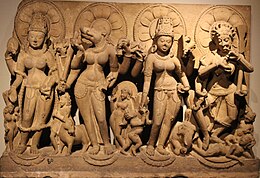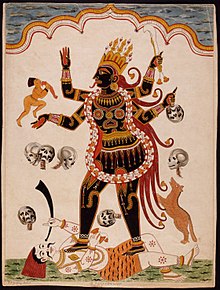沙克提派

| 印度教系列模板 |
| 印度教 |
|---|
 |
沙克提主義(梵語:शाक्तसम्प्रदायः,羅馬化:Śāktasampradāyaḥa;英語:Shaktism,/sˈæktɪzəm/),或稱性力主義、颯刻曇派、沙克提派、沙克達教、提毗派等,是指對於印度教女神沙克提(Shakti,梵語字面意思為「力量」或「能量」等)的崇奉。沙克提主義、毘濕奴主義和濕婆主義是現代印度教的主要形式。沙克提主義在孟加拉和阿薩姆邦尤其流行。沙克提被認為是至高無上的女神,或男性神靈(通常是濕婆)的配偶。[1]
許多印度教徒崇拜沙克蒂,將其視為要求絕對臣服的神聖母親。瑜伽士將沙克蒂視為力量,像一條盤繞的蛇(昆達里尼)一樣潛伏在體內,必須被喚醒並被清楚體認,才能獲得靈性解放。沙克提主義是印度教怛特羅的重要組成部分,這是一種涉及女神崇拜的實踐體系,旨在賦予心智和身體能力並使其自由。[1]
起源與歷史
[編輯]神學
[編輯]經文
[編輯]概述
[編輯]性力派崇拜女神,認為性交是宇宙間的根本動力,是智慧和力量的集中表現。
夏克提和濕婆
[編輯]性力派信徒視女神為至高、終極的神格。她被認為是萬物的起源,同時也是起源的化身和支配控制它的能量。有觀察認為,「全世界信仰的歷史上,沒有其他任何地方經歷過如我們一般,如此完整針對女性的系統」。[2]
性力派對女神的專注並不意味着其對男性或中性神明的拒絕。然而在夏克提存在中,兩者被認為是不活躍的。如商羯羅的第一行的著名的性力派讚美詩美之波流(Saundaryalahari)所述:「若濕婆與夏克提結合,他可以創造(生命)。若他不與夏克提結合,他連攪動一下都不可能。[3]此為性力派之基本教義」。[4]正如廣為人知的女神時母踐踏於看似無生命的濕婆身軀之上的圖畫所強調的那樣。[5]性力派供奉的主神為女神夏克提(明妃),她是「宇宙大能」的來源,她的配偶是男性濕婆,夏克提和濕婆的「永恆擁抱」(性交)構成宇宙,但其中作為動力來源的是夏克提,她的子宮是「噴出諸種能源與生命之口」,濕婆若失去她的擁抱,將只是一具「屍體」。怛特羅認為,男女交合會產生新的生命,是人世間最大的創造性能源,這一能源需與「宇宙大能」匯成一體,其儀式稱為「輪寶供養」。
廣泛而言,認為夏克提是宇宙本身——她是能量和動力的具體化身,物質宇宙中所有行為和存在的背後推力。濕婆是她卓越的男性一面,為神聖的土地提供一切存在。「無夏克提即無濕婆,無濕婆即無夏克提。兩者[……]本身就是一體」。[6]
與怛特羅的聯繫
[編輯]
性力派廣泛流傳的一個誤解是其與怛特羅密教(怛特羅)的緊密聯繫。怛特羅是一個模稜兩可的令人誤解的概念,指稱一切從南印度正統婆羅門寺廟崇拜到北印度黑魔法和隱修,以及藏密與真言宗,到西方的儀式化的性行為(「輪寶供養」,有時被稱為新怛特羅)。連錫克教,耆那教與苯教也與怛特羅有關。[7]事實上,並非所有形式的性力派本質上是怛特羅,正如並非所有怛特羅本質上是性力派一樣。[8]
術語「怛特羅」與正宗印度性力派相關時,它通常主要指一類宗教儀式用書,而更廣泛的,是指一種秘傳的專於女神的靈修方法,涉及mantra,yantra,nyasa,mudra和傳統的昆達利尼瑜伽的特定元素,所有修行都在合格的導師的指導下通過適當的啟發(diksha)和口頭指導以補充各種書面來源。[9]
在社會影響方面,怛特羅「獨立於各種種性與具體的偏見。女人或『首陀羅』被授予上師的角色。所有的女性被視為夏克提顯聖,因此她們是被尊敬和效忠的對象。侵犯她們的人招致偉大女神憤怒。每個男性備修生必須了解自身之中潛在的『女性法則』,且僅以此『成為女性』才能使他被授予膜拜至高存在的資格(因此獻祭時只會用雄性牲畜)」。[10]
主要神明
[編輯]性力派信徒可以接觸以多種形態中的任意一種出現的提毗;但是,他們通常被認為不過是一個至高女神的不同層面。[11]
被性力派信徒膜拜的主要的提毗形態是男性的「ishta-deva」或女性的「ishta-devi」。神祀的選擇取決於許多因素,包括家族傳統,信仰實踐,上師沿襲,個人共鳴等等。字面上,有數千種女神形態,許多與個別寺廟、地理特徵或者甚至是與某個村莊有關。[12]
坦陀羅神明
[編輯]
遊樂母、難近母,時母,吉祥天女,辯才天女。其實不過是大女神摩訶提毗不同形態與化身。
崇拜
[編輯]南亞次大陸有51處性力派重要廟宇徊聖地,多數在東方與南方。斯里蘭卡、孟加拉、尼泊爾、西藏、巴基斯坦也有(這些地方是供奉性力女神屍體某一部分)。
節日
[編輯]性力派信徒慶祝大多數印度教節日,以及龐雜的本地的、特點寺廟或特定神祀的儀式。以下為一些較重要的事件:[13]
難近母節
[編輯]最重要的性力派節日是難近母節(Navaratri,字面意義為「九夜之節」),因其處在印度歷Sharad月份(10/11月),亦作「Sharad Navaratri」。此節日經常與其後第10天——「Dusshera」或「Vijayadashami」一起,慶祝《女神頌》(Devi Mahatmya)中女神難近母對抗一系列強大羅剎的勝利。[14]
排燈節及其他
[編輯]是每年十月祭祀吉祥天女的節日。
寺廟
[編輯]批評與濫用
[編輯]
性力派曾被當作迷信、受黑魔法侵蝕的很難稱得上真正信仰的行為,被數度解散。印度學者在1920年代曾經廣泛發出過類似批評:
「《密續》是性力派(Shaktism)的經典,[…] 它將所有的力量與自然中的女性原則相聯繫,並教導過度崇拜濕婆(Shiva)和毗濕奴(Vishnu)的妻子,而忽略了他們的男性伴侶。[…] 可以確定的是,印度的許多居民在日常生活中受到坦陀羅教義的指引,並被這些著作中灌輸的粗俗迷信所束縛。事實上,幾乎無需懷疑,性力派是印度教發展到最糟糕和最腐化階段的表現。」.[15]
類似言論被認為是基於外接觀察者的無知、誤解和偏見,以及參與者的一些不審慎的行為。「只是在這種語境下,印度的許多印度教徒今天否認怛特羅和他們的信仰曾經與現存的聯繫,認定他們所稱的『tantra-mantra』只是如是胡謅」。
參見
[編輯]參考文獻
[編輯]引用
[編輯]- ^ 1.0 1.1 Shaktism | Goddess Worship, Tantra & Rituals | Britannica. www.britannica.com. 2024-06-13 [2024-08-05]. (原始內容存檔於2024-02-23) (英語).
- ^ Bhattacharyya(a), p.1.
- ^ Subramanian, p.1.
- ^ Dikshitar, p.85.
- ^ "Bengali Shakta."
- ^ Subramanian, p.ix.
- ^ Mohan's World.
- ^ Brooks(a), p.48.
- ^ Brooks(a), pp.47-72.
- ^ Bhattacharyya(a), p.131.
- ^ See Kinsley(a).
- ^ 見Kinsley(a).
- ^ Pattanaik, pp.103-109.
- ^ "5 Things You Need to Know About Navratri: The 9 Divine Nights,"最後一天要殺一頭水牛,山羊,綿羊,雞,鴨。About Hinduism (頁面存檔備份,存於互聯網檔案館).
- ^ Kapoor, p.157.
來源
[編輯]- 書籍
- Anonymous (author), Doniger O'Flaherty, Wendy (translator), The Rig Veda: An Anthology. Penguin Classics Books (London, 1981).
- "Bengali Shakta," World Culture Encyclopedia, South Asia (頁面存檔備份,存於互聯網檔案館)。
- (a) Bhattacharyya, N. N., History of the Sakta Religion, Munshiram Manoharlal Publishers Pvt. Ltd. (New Delhi, 1974, 2d ed. 1996).
- (b) Bhattacharyya, N. N., The Indian Mother Goddess, South Asia Books (New Delhi, 1970, 2d ed. 1977).
- Bolon, Carol Radcliffe, Forms of the Goddess Lajja Gauri in Indian Art, The Pennsylvania State University Press (University Park, Penn., 1992).
- (a) Brooks, Douglas Renfrew, The Secret of the Three Cities: An Introduction to Hindu Shakta Tantrism, The University of Chicago Press (Chicago, 1990).
- (b) Brooks, Douglas Renfrew, Auspicious Wisdom: The Texts and Traditions of Srividya Shakta Tantrism in South India, State University of New York Press (Albany, 1992).
- (a) Brown, C. MacKenzie, The Triumph of the Goddess: The Canonical Models and Theological Issues of the Devi-Bhagavata Purana, State University of New York Press (Suny Series in Hindu Studies, 1991).
- (b) Brown, C. Mackenzie. The Devi Gita: The Song of the Goddess: A Translation, Annotation and Commentary. State University of New York Press (Albany, 1998).
- Coburn, Thomas B., Encountering the Goddess: A translation of the Devi-Mahatmya and a Study of Its Interpretation. State University of New York Press (Albany, 1991).
- Dempsey, Corinne G., The Goddess Lives in Upstate New York: Breaking Convention and Making Home at a North American Hindu Temple. Oxford University Press (New York, 2006).
- Dikshitar, V. R. Ramachandra, The Lalita Cult, Motilal Banarsidass Publishers Pvt. Ltd. (Delhi, 1942, 2d ed. 1991, 3d ed. 1999).
- Erndl, Kathleen M., Victory to the Mother: The Hindu Goddess of Northwest India in Myth, Ritual, and Symbol, Oxford University Press (New York, 1992).
- Harper, Katherine (ed.), The Roots of Tantra, State University of New York Press (Albany, 2002).
- Hawley, John Stratton (ed.) and Wulff, Donna Marie (ed.), Devi: Goddesses of India. University of California Press (Berkeley, 1996).
- (a) Johnsen, Linda. The Complete Idiot's Guide to Hinduism. Alpha Books (Indianapolis, Ind., 2002).
- (b) Johnsen, Linda, The Living Goddess: Reclaiming the Tradition of the Mother of the Universe." Yes International Publishers (St. Paul, Minn., 1999).
- Joshi, L. M., Lalita Sahasranama: A Comprehensive Study of the One Thousand Names of Lalita Maha-tripurasundari. D.K. Printworld (P) Ltd (New Delhi, 1998).
- Kali, Davadatta, In Praise of the Goddess: The Devimahatmya and Its Meaning. Nicolas-Hays, Inc., Berwick, Maine, 2003).
- Kapoor, Subodh, A Short Introduction to Sakta Philosophy, Indigo Books (New Delhi, 2002, reprint of c. 1925 ed.).
- (a) Kinsley, David. Hindu Goddesses: Visions of the Divine Feminine in the Hindu Religious Tradition. University of California Press (Berkeley, 1988).
- (b) Kinsley, David. Tantric Visions of the Divine Feminine: The Ten Mahavidyas. University of California Press (Berkeley, 1997).
- Krishna Warrier, Dr. A.J., The Sākta Upaniṣad-s, The Adyar Library and Research Center, Library Series, Vol. 89; Vasanta Press (Chennai, 1967, 3d. ed. 1999).
- Kumar, Girish, "Introduction to Tantra Sastra, Part I." Interview with Sri Girish Kumar, former director of Tantra Vidhya Peethama, Kerala, India, Mohan's World
- Müller, F. Max (translator), The Upanishads. Realization.org (頁面存檔備份,存於互聯網檔案館)
- Nikhilananda, Swami (trans.), The Gospel of Sri Ramakrishna, Ramakrishna-Vivekananda Center (New York, 1942, 9th ed. 2000).
- Pattanaik, Devdutt, Devi the Mother-Goddess: An Introduction. Vakils, Feffer and Simons Ltd. (Mumbai, 2000).
- Pechilis, Karen (ed.), The Graceful Guru: Hindu Female Gurus in India and the United States. Oxford University Press (New York, 2004).
- Sarma, Dr. S. A., Kena Upanisad: A Study From Sakta Perspective. Bharatiya Vidya Bhavan (Mumbai, 2001).
- (a) Shankarnarayanan, S., The Ten Great Cosmic Powers: Dasa Mahavidyas. Samata Books (Chennai, 1972; 4th ed. 2002).
- (b) Shankarnarayanan, S., Sri Chakra. Samata Books (Chennai, 1971; 4th ed. 2002).
- Subramanian, V. K., Saundaryalahari of Sankaracarya: Sanskrit Text in Devanagari with Roman Transliteration, English Translation, Explanatory Notes, Yantric Diagrams and Index. Motilal Banarsidass Publishers Pvt. Ltd. (Delhi, 1977; 6th ed. 1998).
- Subramuniyaswami, Satguru Sivaya, Merging with Siva: Hinduism's Contemporary Metaphysics, Himalayan Academy (Hawaii, USA, 1999).
- Suryanarayana Murthy, Dr. C., Sri Lalita Sahasranama with Introduction and Commentary. Bharatiya Vidya Bhavan (Mumbai, 2000. Rep. of 1962 ed.).
- Urban, Hugh B., Tantra: Sex, Secrecy, Politics and Power in the Study of Religion, University of California Press (Berkeley, 2003).
- Vanamali, Mataji Devi, Shakti: Realm of the Divine Mother, Inner Traditions (Rochester, Vermont USA, 2008).
- White, David Gordon, Kiss of the Yogini: "Tantric Sex" in its South Asian Contexts, The University of Chicago Press (Chicago, 2003).
- Winternitz, M., History of Indian Literature, 2 vols. (Calcutta, 1927, 1933, rep., New Delhi, 1973).
- Woodroffe, Sir John, Sakti and Sakta: Essays and Addresses, Ganesh & Company (Madras, 9th Ed. 1987, reprint of 1927 edition).
- Yadav, Neeta, Ardhanārīśvara in Art and Literature. D. K. Printworld (P) Ltd. (New Delhi, 2001).



